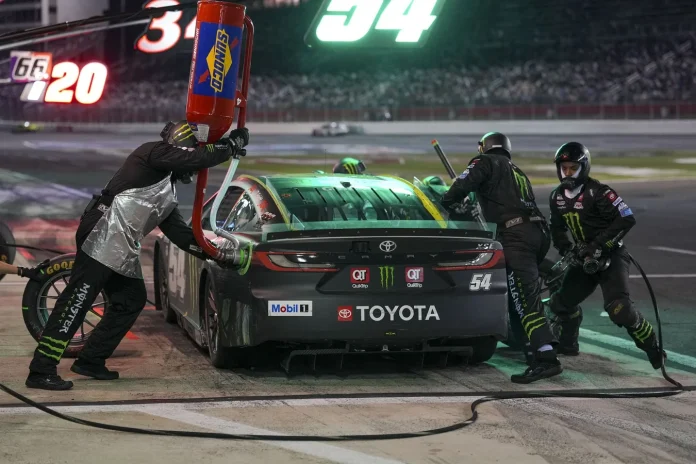The recent Ty Gibbs pit road controversy analysis at Sonoma Raceway stirred heated debate in the NASCAR world, as Dale Earnhardt Jr. offered a provocative perspective by comparing the incident to tactics seen in professional baseball. As Gibbs became once again the focal point for questions of intent and fair play, Earnhardt Jr. dissected the drama with pointed insights on his Dirty Air podcast.
Connecting Baseball Tactics to Racing Incidents
Dale Earnhardt Jr. drew parallels between the high-stakes moments of NASCAR and the strategic maneuvers found in baseball, seizing on a fan’s social media observation as a starting point.
“I saw this comment on social media, a guy named Jerry, I believe. He said that this was akin to the brushback pitch in baseball,”
—Dale Earnhardt Jr., NASCAR Hall of Famer,
he explained to his podcast co-host TJ Majors.
Elaborating on the comparison, Earnhardt Jr. continued,
“You’ll throw high and inside and get the batter to back up off the plate. Or, you know, a pitcher might throw a pitch… maybe something happened in the game. There was some contact or a bad pitch from the previous inning that p*ssed everybody off on that team, and the pitcher for the other team goes in and gets one in there tight against the batter and it’s like a message, right?”
—Dale Earnhardt Jr., NASCAR Hall of Famer
This analogy placed the pit road confrontation within the framework of sporting retaliation and gamesmanship, suggesting that the on-track drama goes beyond simple mistakes.
The trouble began when Ty Gibbs and Chris Buescher collided in Turn 11 during the second stage, with Gibbs blocking Buescher’s advance, leading to contact that spun Gibbs out. Earnhardt Jr. highlighted this as a core principle in racing: block, and there may be consequences. But the major flashpoint arrived when Gibbs drove through Brad Keselowski’s pit box, making contact with tire carrier Telvin McClurkin. With Gibbs’ record of previous penalties—including substantial fines—the situation reignited criticism and suspicion among NASCAR observers.
Earnhardt Jr. continued his analogy, saying,
“I would say if anything that’s what this is, which in baseball, that’s kind of part of the game, right?”
—Dale Earnhardt Jr., NASCAR Hall of Famer
His commentary underscored how such incidents, while controversial, are often tolerated as inherent strategies in competitive environments.
Isolating Intent: A Difficult Task in NASCAR
Earnhardt Jr.’s analysis drilled deeper into the question of whether Ty Gibbs acted with intent. The challenge, he argued, resides in determining a driver’s mindset, an often elusive standard in sports.
“If you could prove it to be intentional? …How could you prove it? That’s the question. So we can’t prove it. I don’t think you can prove it unless he admits it.”
—Dale Earnhardt Jr., NASCAR Hall of Famer
Earnhardt Jr. reflected on the practical impossibility of proving intent without explicit admission, a dilemma common in incidents like this where motives are unclear.
Following review of the incident, NASCAR officials decided that Gibbs did not violate any rules, affirming the right of way for drivers leading into pit lane. Earnhardt Jr. confirmed this, stating,
“Looking at the film, he did — he broke no rule,”
—Dale Earnhardt Jr., NASCAR Hall of Famer
and
“He didn’t do anything that you could penalize.”
—Dale Earnhardt Jr., NASCAR Hall of Famer
The decision did little to quell discussion, however, as Gibbs’ reputation influenced public perception. Earnhardt Jr. addressed this nuance,
“Because it’s Ty Gibbs. If this was, you know, Chase Elliott, someone else, we wouldn’t be having the same outrage,”
—Dale Earnhardt Jr., NASCAR Hall of Famer
and further explained,
“Ty Gibbs has created the narrative”
—Dale Earnhardt Jr., NASCAR Hall of Famer
pointing to Gibbs’ prior on-track conflicts as fuel for ongoing controversy.
This comparison to baseball’s “brushback pitch” illustrated the complex space in which competitive aggression collides with questions of retaliation, keeping the intent behind drivers’ actions in constant debate.
Examining the Lasting Impact of the Sonoma Controversy
The latest Ty Gibbs pit road controversy analysis at Sonoma, as deconstructed by Dale Earnhardt Jr., highlights how NASCAR must continually address the challenge of parsing competitive intensity from deliberate foul play. With repeated incidents involving Gibbs, and figures like Chris Buescher, Telvin McClurkin, and Brad Keselowski all swept up in the aftermath, NASCAR’s rulings remain under scrutiny from both fans and former drivers. The debate over intent versus outcome will likely persist, especially when reputations and prior actions shape the narrative around controversial moments on track.
Our Reader’s Queries
Q. Why does Ty Gibbs drive the 54?
A. In 2022, Gibbs raced full-time in the Xfinity Series. He drove the No. 54 Toyota owned by his grandfather, Joe Gibbs. That same year, Gibbs impressed many by winning seven races and qualifying for the playoffs. He also had the opportunity to compete in the Cup Series at Pocono Raceway.
Q. Is Ty Gibbs any good?
A. This season, Racing Insights places Gibbs among the top 10 in passing, defense, and restarts on road courses, with a fourth-place average running position of 10.92.
Q. Has Ty Gibbs ever won?
A. Ty Gibbs, the grandson of NASCAR team owner Joe Gibbs, made a big impact in 2021 by winning his first Xfinity Series race at the Daytona Road Course. In 2022, Gibbs became a full-time Xfinity Series driver and won the championship in his debut season.
Q. Has Ty Gibbs won?
A. In 2022, Gibbs started competing full-time in the Xfinity Series and won the championship during his debut season.

